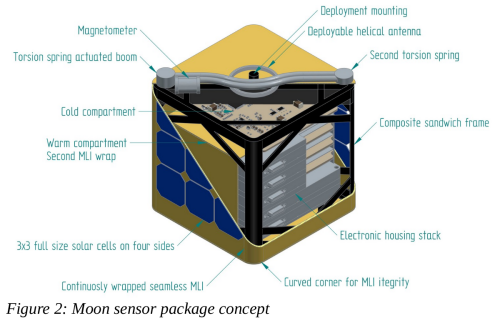- 1Finnish Meteorological Institute, Helsinki, Finland (maria.hieta@fmi.fi)
- 2National Institute of Aerospace Technology, INTA, Madrid, Spain
- 3Added Value Solutions, AVS, Spain
- 4Universitat Politècnica de Catalunya (UPC), Barcelona, Spain
- 5Instituto de Microelectrónica de Sevilla (IMSE), Sevilla, Spain
- 6IMDEA Nanociencia, Madrid, Spain
- 7Astrobiology Center, INTA/CSIC, Spain
- 8Talvioja Consulting Ltd., Finland
- 9Elomatic Ltd., Finland
Introduction: Simultaneous, distributed in situ measurements would benefit scientific investigations of both Mars and Moon. On Mars the global and related local phenomena such as atmospheric circulation patterns, boundary layer phenomena, water, dust and climatological cycles and investigations of the planetary interior would be ideal objects for in situ network studies. On the Moon the possibility of using an network of sensing platforms will enable the study the formation of the Solar System based on the Moon evolution, by dating craters and basins as well as to the study of the Lunar interior as the evolution of a differentiated planetary body. Such observation networks would require miniature low-mass landers, with a suite of sensors for a range of scientific measurements. We present an ESA study named “MiniPINS” to develop suitable sensor packages for aforementioned purposes.
The MiniPINS study: MiniPINS is an ESA study led by the Finnish Meteorological Institute to develop and prototype miniaturised surface sensor packages (SSPs) and their delivery methods for Mars and the Moon. The study aims at miniaturising the scientific sensors and subsystems, as well as identifying and utilizing commonalities of the packages, allowing to optimise the design, cut costs and reduce the development time. The 1.5-year study began in January 2020 and is currently in phase A. So far multiple different concepts for both Mars and Moon have been investigated, including a separating forebody for Mars penetrator and power systems with and without RHU for Moon SSP, and several trade-off analysis have been performed to select the concepts that fulfill the mission needs and scientific goals. The selected concepts will be presented in EPSC 2020.
Mars sensor package: The Mars SSP will be a small 25 kg penetrator deployed from a Mars orbiter. Four (4) penetrators will be carried to the Martian orbit by an orbiter and the orbiter will be oriented for deployment of each penetrator. The SSP’s can be delivered to Mars for example by Mangalyaan-2 or MMX and no dedicated orbiter for the SSP’s is foreseen. In the Martian atmosphere the penetrators undergo aerodynamic braking until they reach the target velocity for entering the Martian surface. The SSP is utilizing inflatable state-of-the-art entry, descent and landing (EDL) technologies, heritage from MetNet Lander development [1]. The shock-absorption system limits the deceleration experienced by the payload during landing impact utilizing mechanical deformation. The SSPs will start their scientific observations after landing and stay stationary throughout their nominal mission of 2 years. The SSPs have an ambitious science program and their payloads consist initially of a camera, a visual spectrometer, a meteorological package, an accelerometer, thermoprobes, a magnetometer, a chemistry package and a radiation monitor. The SSP will also provide positioning signal and communications link to the orbiter. The final scientific case will be selected throughout the study.
Moon sensor package: The Moon SSP will be a miniature 5 kg station deployed on the Moon surface by a rover. Four (4) SSPs are deployed from a rover with low velocity and small impact depth (max. 0.05 m). The Moon SSP is a good match to be delivered by the European Large Logistic Lander (EL3) which is a part of the ESA-led HERACLES mission [2]. The proposed landing site for the HERACLES is the Schrödinger crater, located at the South Pole Aitken Basin. The Moon SSP utilizes an European Radioisotope Heating Unit (RHU) [3] to survive the Lunar night, when the surface temperature will reach the minimum of -170°C, and to provide thermalization for the system electronics such as batteries, and for the scientific instruments. The RHU also enables to select from wider variation of landing locations compared to using only solar panels as an energy source. The SSPs will start their scientific observations after landing and study for example radiation, seismology, magnetic field and chemistry. SSP will also provide communications link to a relay orbiter. Some instruments such as the camera, the accelerometer, thermoprobes, the magnetometer, the radiation monitor and the seismometer, can be common between both Mars and Moon packages and the possibility is investigated during this study.

Summary: Both Mars and Moon SSPs will be miniaturised, light and robust, and still capable of surviving high G loads (Mars SSP) and extreme thermal environments. SSPs are capable of working on the surface of Mars or Moon for at least 2 years and to produce high quality science data with state of art instrumentation. The critical technologies identified in this study so far include the development of inflatable aerodynamic devices, shock and penetration testing of the Mars SSP and dimensioning of energy needs and identification of harvesting and storage technologies, as well as the definition of ultra-low power operation modes. The output of this work will enable ESA to prepare and plan for technology development programs required to implement such ambitious planetary missions.
References: [1] Harri A-M et al. (2017), Geosci. Instrum. Method. Data Syst. 6, 103-124. [2] Hiesinger H. (2019), Lunar and Planetary Science Conference, 1327. [3] Ambrosi, R. M. (2019), Space Science Reviews 215, 55.
How to cite: Hieta, M., Genzer, M., Haukka, H., Kestilä, A., Arruego, I., Apéstigue, V., Martínez, J., Reina, M., Ortega, C., Camañes, C., Sard, I., Dominguez, M., Espejo, S., Guerrero, H., Rodríguez Manfredi, J. A., Talvioja, M., Kivekäs, J., Koskimaa, P., and Palin, M.: MiniPINS - Miniature in situ sensor packages for Mars and Moon, Europlanet Science Congress 2020, online, 21 Sep–9 Oct 2020, EPSC2020-858, https://doi.org/10.5194/epsc2020-858, 2020.

